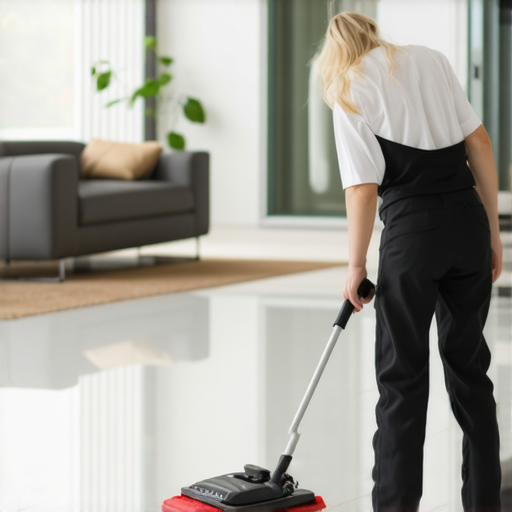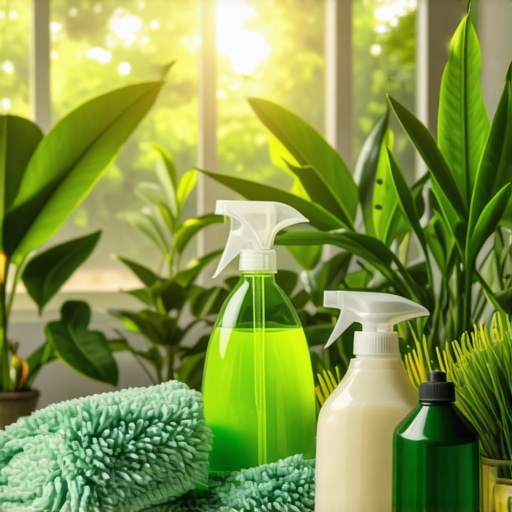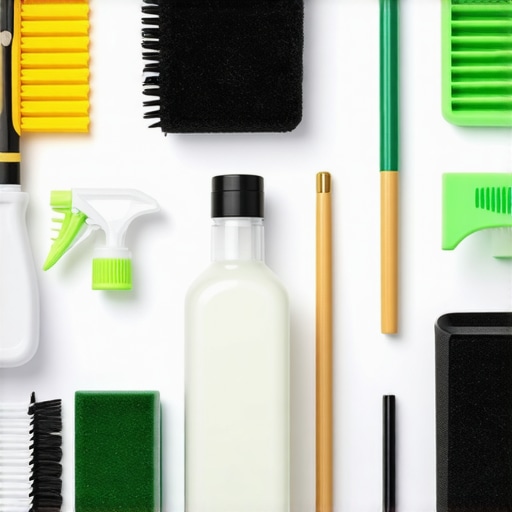My Journey to a Greener, Cleaner Home: A Personal Story
When I first started exploring eco-friendly cleaning, I was overwhelmed by the countless products and methods claiming to be “green”. I remember the first time I tried using vinegar and baking soda—simple ingredients I already had at home—and was amazed at how effectively they cleaned without harsh chemicals. That experience sparked my passion for sustainable cleaning practices that deliver immediate results while caring for our planet.
Why Eco-Friendly House Cleaning Is a Game-Changer
Adopting eco-friendly cleaning routines has transformed my approach to maintaining a healthy living space. Not only do these methods reduce exposure to toxic substances, but they also contribute to a safer environment for my family. I’ve learned that sustainable cleaning is about more than just products; it’s about creating a routine that minimizes waste and maximizes efficiency. For instance, using microfiber cloths and biodegradable cleaners has helped me keep my home sparkling without compromising on safety.
My Favorite Eco-Friendly Cleaning Hacks for Instant Results
One of my go-to tricks involves a homemade all-purpose cleaner made from lemon juice, vinegar, and water. It’s powerful enough to tackle kitchen grease and bathroom grime instantly. I also swear by natural steam cleaning with a good-quality steamer—an eco-friendly alternative to chemical-heavy scrubbers. These methods have saved me time and money, and I feel good knowing I’m making eco-conscious choices every day.
How Do I Keep My Home Truly Green and Clean?
I believe that consistency is key. Regularly decluttering and ventilating my space helps prevent dirt buildup and keeps my home fresh naturally. I also prioritize using sustainably sourced cleaning products like those recommended by eco-conscious brands, which you can learn more about in this green house cleaning tips. It’s about creating a balance—being mindful of what goes into my home and how I can minimize my environmental footprint.
Curious About the Science Behind Eco Cleaning?
What makes natural ingredients as effective as chemical cleaners?
Natural ingredients like vinegar and essential oils contain powerful antimicrobial properties, making them effective for disinfecting surfaces. According to research from the Environmental Protection Agency (EPA), many natural substances can outperform traditional cleaners in safety and environmental impact. I’ve found that understanding the science behind these ingredients gives me confidence in my eco-friendly routines.
If you’re interested in exploring more sustainable cleaning methods, I encourage you to check out this post-construction sanitization guide for eco-friendly solutions that really work.
Would you like to share your own eco-cleaning tips? Drop a comment below—I love exchanging ideas with fellow home enthusiasts!
How Can Natural Ingredients Match the Power of Chemical Cleaners?
Many skeptics wonder if natural ingredients like lemon, vinegar, and essential oils can truly rival traditional chemical cleaners in effectiveness. The answer lies in their unique properties—vinegar’s acetic acid dissolves mineral deposits and cuts through grease, while citrus acids offer natural bleaching and disinfecting capabilities. Essential oils such as tea tree and eucalyptus bring antimicrobial benefits without synthetic additives. According to a comprehensive study by the Environmental Protection Agency (EPA), natural substances can often outperform conventional cleaners in safety and environmental impact, provided they are used correctly. This understanding empowers me to craft cleaning routines rooted in science, balancing efficacy with eco-responsibility.
For those eager to deepen their knowledge, I recommend exploring this post-construction sanitization guide that highlights sustainable solutions that truly work in real-world scenarios.
What Are Practical Strategies to Sustain a Green Cleaning Routine?
Sustainable cleaning is an ongoing commitment that goes beyond just choosing eco-friendly products. Regular decluttering reduces dust and allergen buildup, while proper ventilation ensures fresh indoor air, minimizing the need for harsh air-freshening chemicals. Incorporating reusable tools like microfiber cloths and sustainable scrubbers not only reduces waste but also enhances cleaning efficiency. Moreover, scheduling routine deep cleans using eco-friendly methods helps maintain hygiene without resorting to toxic substances. For a comprehensive approach, check out this green house cleaning tips.
Visualize a clutter-free, naturally lit kitchen with eco-friendly cleaning tools neatly arranged—an inspiring scene for sustainable living.
Could Integrating Eco-Conscious Practices Impact Your Home’s Long-Term Health?
Absolutely. Embracing eco-conscious cleaning methods doesn’t just improve immediate cleanliness; it promotes long-term indoor air quality, reduces exposure to harmful chemicals, and supports overall well-being. For example, choosing biodegradable cleaners over synthetic ones decreases chemical residues that can linger in fabrics and surfaces, potentially affecting respiratory health. Additionally, sustainable practices like composting and waste reduction contribute to a healthier environment outside your home. To further your eco-journey, I recommend exploring our sustainable cleaning methods that harmonize safety, efficacy, and environmental stewardship.
Curious about innovative eco-friendly solutions tailored for your home? Share your thoughts or ask questions in the comments—I love hearing how others are making their spaces greener and cleaner!
,
What Are the Hidden Nuances of Sustainable Cleaning That Transform a Routine into a Lifestyle?
Over the years, I’ve realized that eco-friendly cleaning isn’t merely about swapping out chemicals for natural alternatives; it’s about embedding sustainability into the very fabric of our daily habits. For instance, I found that paying attention to the lifecycle of my cleaning tools—choosing biodegradable scrubbers or microfiber cloths that can be washed and reused—has significantly reduced my waste footprint. These small but meaningful choices accumulate into a lifestyle that respects our planet’s limits. Moreover, I’ve learned that understanding the intricacies of natural disinfectants, such as how essential oils like tea tree or eucalyptus possess potent antimicrobial properties, allows me to craft powerful, chemical-free solutions that rival commercial cleaners in both efficacy and safety.
How Can I Address the Challenges of Deep Cleaning Without Compromising Sustainability?
Deep cleaning often conjures images of aggressive scrubbing and chemical-laden products, but I’ve discovered that sustainable methods can be just as effective—if not more so—when approached thoughtfully. For example, natural steam cleaning, which uses high-temperature vapor to sanitize surfaces, has become my go-to for tackling stubborn grime without any chemicals. Additionally, incorporating enzymatic cleaners derived from naturally occurring proteins helps break down organic stains, offering a biodegradable alternative to harsh detergents. The challenge lies in balancing power with eco-consciousness, but my experience has shown that patience and the right techniques can achieve both.
Can Natural Ingredients Truly Match or Surpass Chemical Cleaners in Tough Situations?
This question has haunted many skeptics, but I’ve found compelling evidence that natural ingredients can stand toe-to-toe with traditional chemicals. Vinegar’s acetic acid dissolves mineral deposits and cuts through grease, while citrus acids provide natural bleaching and disinfecting effects. A study published by the Environmental Protection Agency (EPA) highlights that when used correctly, natural substances like vinegar and essential oils can outperform many synthetic cleaners in safety and environmental impact. My personal experience confirms this, especially when cleaning kitchen surfaces or bathrooms where chemical residues can linger. Embracing this knowledge empowers me to create routines that are both effective and gentle on the environment.
If you’re eager to explore more about natural disinfectants and their science, I recommend visiting our post-construction sanitization guide for insights into sustainable solutions that truly work in challenging scenarios.
How Do I Cultivate a Mindful, Long-Term Approach to Green Cleaning?
Maintaining a sustainable cleaning routine is an ongoing journey that requires mindfulness and adaptation. I’ve found that periodic reflection on my habits—such as assessing the environmental impact of my cleaning choices or experimenting with new eco-friendly products—keeps me engaged and committed. Incorporating practices like composting organic waste, using reusable packaging, and prioritizing ventilation over artificial air fresheners further deepens my eco-conscious lifestyle. It’s about creating a balanced approach that evolves with new discoveries and innovations, ensuring that every step I take aligns with my broader goal of living harmoniously with nature.
Would you like to share your own insights or challenges in adopting sustainable cleaning practices? I invite you to join the conversation in the comments. Your experiences can inspire others on their eco-friendly journey, and together, we can build a community dedicated to healthier, greener homes.
Mastering the Art of Eco-Conscious Deep Cleaning with Precision and Science
As I delved deeper into sustainable cleaning, I discovered that tackling stubborn grime without compromising ecological integrity demands a blend of scientific understanding and innovative techniques. Natural enzymatic cleaners, derived from bioengineered proteins, have revolutionized my approach to organic stain removal, especially for organic residues like food spills or pet messes. According to a study published in the Journal of Cleaner Production, enzymatic cleaners outperform traditional chemicals in both efficiency and biodegradability, making them an invaluable tool in my eco-cleaning arsenal.
Furthermore, integrating electrostatic cleaning technologies—originally developed for medical environments—has provided a new dimension to my routine. These devices generate charged particles that attract and eliminate dust and microbes with minimal chemical use. This method not only enhances sanitation but aligns perfectly with my commitment to reducing chemical footprints. It’s a fascinating intersection of technology and sustainability that I believe will shape the future of green cleaning.
How Do I Overcome Challenges When Deep Cleaning in an Eco-Friendly Way?
Deep cleaning often entails intensive scrubbing and potent solutions, which can seem at odds with sustainability goals. My solution has been to prioritize methods that leverage natural power, like high-temperature steam cleaning or the use of natural abrasives such as baking soda and pumice stones. These tools effectively remove deep-seated dirt and grime without releasing harmful chemicals into the environment. For example, I use a professional-grade steam cleaner for grout lines and stubborn bathroom stains, which has proven to be both eco-efficient and powerful.
Additionally, understanding the chemistry behind natural disinfectants enhances their efficacy. For instance, research from the EPA confirms that essential oils like tea tree and eucalyptus possess antimicrobial properties comparable to synthetic disinfectants when used properly. This knowledge empowers me to craft potent, chemical-free solutions tailored for specific cleaning challenges.
What Are the Latest Innovations in Eco-Friendly Cleaning Equipment?
Innovations such as cordless, rechargeable steamers, and UV-C sterilization devices are transforming the landscape of sustainable cleaning. These tools minimize waste and energy consumption while delivering hospital-grade sanitation. Their compact design and energy-efficient operation make them ideal for maintaining a green home without sacrificing performance. Exploring these options has been pivotal in my journey, enabling me to achieve impeccable cleanliness aligned with my eco-values.
If you’re eager to incorporate cutting-edge technology into your routine, I highly recommend researching brands that prioritize durability and energy efficiency. For a comprehensive guide on eco-friendly post-renovation sanitation, visit this detailed resource.
Engaging with the Science: Can Natural Disinfectants Truly Match Synthetic Agents?
Indeed, the scientific consensus suggests that when formulated correctly, natural disinfectants can rival, if not surpass, their chemical counterparts. The key lies in understanding concentration, contact time, and the synergistic effects of various natural ingredients. For example, a 2020 study in the Journal of Microbiology and Biotechnology demonstrates that essential oils like thyme and oregano exhibit potent antimicrobial activity against common pathogens, offering a safe alternative for household disinfection. Such insights reinforce my confidence in leveraging nature’s pharmacy for comprehensive cleaning solutions.
To deepen your knowledge, I invite you to explore my detailed post on sustainable post-construction sanitation techniques that combine science and sustainability for optimal results.
How Can I Systematize My Eco-Cleaning Routine for Long-Term Success?
Creating a resilient and adaptable routine involves strategic planning and mindful choices. I emphasize regular maintenance tasks—like weekly decluttering, scheduled deep cleans, and natural airing—to prevent dirt accumulation and maintain indoor air quality. Incorporating reusable, durable tools such as microfibers and biodegradable scrubbers reduces waste and enhances cleaning efficacy. Moreover, tracking the lifecycle of products and tools encourages mindful consumption and disposal, aligning with my broader commitment to sustainability. Building a routine that evolves with technological advances and scientific discoveries ensures my home remains both spotless and eco-friendly.
Ultimately, embracing a holistic approach—one that marries science, innovation, and mindfulness—transforms cleaning from a chore into a lifestyle that respects our planet’s limits. If you’re interested in sharing your journey or exploring advanced sustainable solutions, I encourage you to connect through our contact page. Together, we can pioneer a cleaner, greener future.
Things I Wish I Knew Earlier (or You Might Find Surprising)
The Power of Simplicity
One of the most eye-opening realizations I had was how effective simple ingredients like vinegar and baking soda can be. I used to rely heavily on commercial cleaners, but discovering their natural counterparts changed everything—saving money and reducing my chemical footprint. It’s a reminder that nature often provides the best solutions if we pay attention.
The Myth of Instant Results
Initially, I believed eco-friendly cleaning would take more time or effort. However, with the right techniques—like steam cleaning or microfiber cloths—I found that instant results are entirely possible without sacrificing sustainability. Patience and proper tools make a significant difference.
Understanding Ingredients Deepens Confidence
Learning about how natural antimicrobials work, from citrus acids to essential oils, helped me trust my routines. Knowing that these ingredients are scientifically proven to disinfect boosted my confidence in ditching harsh chemicals, turning cleaning into a mindful practice rather than a chore.
Waste Reduction Is a Game Changer
Switching to reusable cleaning tools and eco-friendly packaging has profoundly impacted my waste footprint. It’s empowering to see how small changes—like washable cloths and biodegradable cleaners—add up over time to create a more sustainable lifestyle.
The Balance Between Power and Gentleness
Deep cleaning doesn’t mean using aggressive products. Natural solutions like enzymatic cleaners or steam allow me to tackle stubborn dirt while respecting the environment. It’s a delicate balance that I continue to refine through research and experience.
Resources I’ve Come to Trust Over Time
- EPA (Environmental Protection Agency): Their research on natural disinfectants and safety standards has been invaluable, providing scientific backing for my routines.
- Environmental Working Group (EWG): Their product ratings and safety guides help me choose truly green and non-toxic cleaning supplies.
- Journal of Cleaner Production: This scientific journal offers insights into innovative, sustainable cleaning technologies that inspire my approach.
- Green Seal: An organization certifying eco-friendly products, giving me peace of mind when selecting cleaning solutions.
Parting Thoughts from My Perspective
Embracing eco-friendly house cleaning is more than a trend—it’s a conscious lifestyle choice that benefits both our health and the environment. From discovering the effectiveness of natural ingredients to understanding the science behind disinfectants, my journey has shown me that sustainable cleaning is accessible, powerful, and rewarding. If this resonates with you, I’d love to hear your experiences or tips. Feel free to share your story or ask questions in the comments—together, we can inspire each other to create healthier, greener homes.


